Sold Ceramics
Sold Famille Rose wares 1725-1800
Dishes
Page 2
There was great demand for Chinese porcelain in Europe at the end of the 17th century. This led to the production of a variety of shapes and decorations while the competition between private merchants also contributed to a very varied supply. Besides porcelain decorated in underglaze blue, famille verte and Chinese Imari, many other types emerged, decorated with overglaze enamels that were sometimes combined with underglaze blue. The most important development, however, was the use of a pink-red enamel around 1725. Porcelain decorated with this enamel is called famille rose. Within a very short time this type supplanted famille verte and became the popular choice for all kinds of export porcelain. Mixing the rose with white enamel created shades of colour that suggested depth and volume. Famille rose knows a great variety in quality and decorations. The name was invented in the 19th century; before that it was simply called 'enameled'. Rose enamel was first developed in the Imperial workshops in Beijing and applied on enameled copper and bronze objects. Western chemical knowledge introduced by the Jesuits at the court around 1700 probably played a role. Since c.1725 it also was used on porcelain in Jingdezhen. Initially, the colour had a lilac shade but became a proper pink after c.1730. It was applied rather thickly and, unlike the very thin iron-red, can easily be felt on top of the glaze. Rose was applied on all types of export porcelain and there are countless combinations with other enamels.

Sold Ceramics - Sold Famille Rose wares 1725-1800 - Dishes - Page 2
Object 2011720
Dish
China
c.1735-1745
Height 43 mm (1.69 inch), diameter of rim 353 mm (13.90 inch), diameter of footring 194 mm (7.64 inch), weight 958 grams (33.78 ounce (oz.))
Dish on footring, wide flat, underglaze brown-edged, rim (jia mangkou). Decorated in 'Red & Gold' / 'Rouge-de-fer' with iron-red and gold combined with various famille rose overglaze enamels. The centre with a reserved medallion formed by linked ruyi, painted in black enamel with flowering peony and chrysanthemum plants, a vase filled with flowering hibiscus branches and a riverscape within an unfurled scroll with ribbons. On the rim half flowerheads with a leafy flowering stem reserved on a cell-pattern ground alternating with half flowerheads with leafy scrolls. The reverse is undecorated.
This combined decoration of late 'Red & Gold' / 'Rouge-de-fer' with polychrome enamels is uncommon and rare, especially on dishes of this size.
For another dish decorated in 'Red & Gold' / 'Rouge-de-fer' combined with polychrome famille rose overglaze enamels, please see:
Condition: Some loss of enamel and some slight wear to the iron-red decoration. A star-shaped hairline to the base.
References:
Jacquemart & Le Blant 1862, pp. 77-105
Price: Sold.

Sold Ceramics - Sold Famille Rose wares 1725-1800 - Dishes - Page 2
Object 2012435
Dish
China
1730-1745
Height 48 mm (1.89 inch), diameter of rim 352 mm (13.86 inch), diameter of footring 196 m (7.72 inch), weight 1,192 grams (42.05 ounce (oz.))
Dish on footring, wide flat rim. Decorated in various famille rose enamels and gold with flowering peonies, begonias, chrysanthemums and other flowers in a complex cartouche. On the sides and rim flowering peony and chrysanthemum sprays on a whorl-pattern ground flanked by flower heads alternating with cartouches filled with a tied flower head with swirling ribbons and a pearl ribboned pendant with Chinese stone chimes and a ruyi with three ribboned pearl pendants. On the reverse two large peony flower sprays in iron-red. On the base a rectangular paper label which reads: '4000'.
The begonia comes in a variety of flower colours. In Chinese older times, it represents happiness and beauty, due to its blooming and attractive flowers. It has been mentioned in poems and literatures where it often is related to pretty ladies. In the Chinese art and craft world, the word ‘begonia shape’ is used to descript a certain shape or form similar to the begonia flower head. (I am indebted to Mr. S. Fan, Doncaster for this information)
It has been suggested that the objects the just above the ruyi are tied Chinese stone chimes moved by the wind, which is also indicated by the swirling green ribbons. (I am indebted to Mr. D. Ballanger, France for this information)

Chinese stone chimes (source: www.chinesecio.com)
Little dates this dish at about 1740, as Meissen copies from this date are known. (Lion-Goldschmidt 1957)
In the late 17th / early 18th century porcelain with enamelled decoration became very successful. This continued throughout the 18th century and an even greater assortment of shapes, colours and techniques developed. The rose/pink colour was an important addition to the palette. In 1862 Jacquemart and le Blant categorized the various enamel decorating colours, wares with this pink enamel in the decoration were named famille rose. The knowledge of how to make the colour reached Jingdezhen in the early 1720s and porcelain with an opaque pink enamal was made from c.1725 onwards. Early examples have a rather dull, mauve tint but soon the colour became more vibrant and semi opaque, although it did not achieve the transparency of the verte enamels. By mixing the pink with the recently developed lead/arsenic white enamel different grades of opaqueness could be obtained as well as various intensities of pink. The new colour soon became immensely popular and was combined with other enamels such as green, iron-red, overglaze blue, turquoise, brown and black, while gilding was applied to enhance details. After c.1730 famille rose rapidly succeeded famille verte as the main style of enamelling for the Western export markets. About half of the regular export assortment of the VOC and other companies consisted of 'enamelled' wares, as polychrome porcelain was generally called then, with the pink enamel dominant in a palette. These more ordinary wares were less refined and not so well painted but they nevertheless sold very well in Europe. Generally speaking, enamelled decorations on export porcelain of the second half of the 18th century tend to become somewhat stiff and uninspired, repeating the well-known motifs without much variation in rather dense compositions. However, in the late 18th and early 19th centuries a revival began, probably due to the interest of the Americans as new buyers. (Jörg & Van Campen 1997)
For identically decorated dishes, please see:
- Les poteries et porcelaines chinoises, (D. Lion-Goldschmidt, Presses Universitaires de France, Paris 1957), pl. 27, A.
- Porcelaines des Compagnies des Indes de la collection du Musée des Beaux-Arts de Montréal/ Oriental Export Porcelain from the Collection of the Montreal Museum of Fine Arts, (R. Little, Montreal Museum of Fine Arts, Canada 1992), p.57, cat. 30.
- Ostindisk Porselen i Norge (J. Huitfeldt, Huitfeldt Forlag A.S., Oslo, 1993), p.114.
Condition: A firing flaw in the centre.
References:
Jacquemart & Le Blant 1862, pp. 77-105
Lion-Goldschmidt 1957, pl. 27, A
Jörg & Van Campen 1997, pp.205-207
Price: Sold.
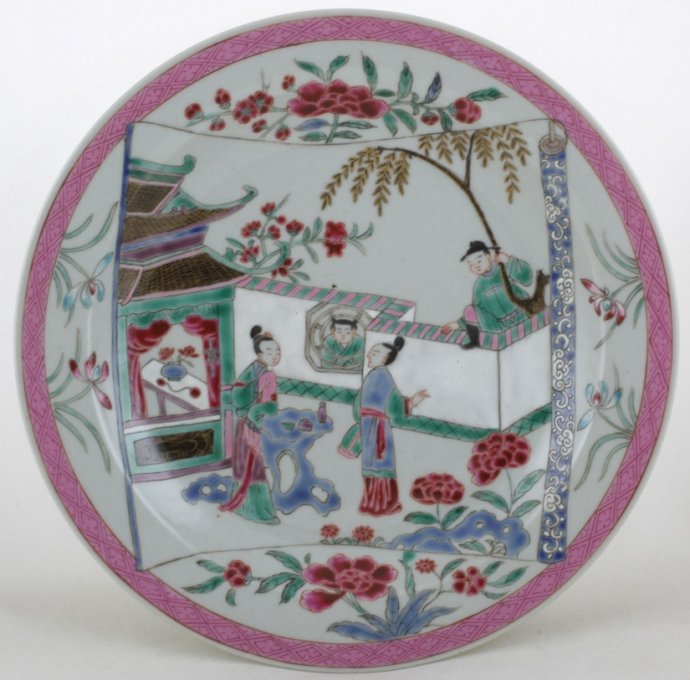
Sold Ceramics - Sold Famille Rose wares 1725-1800 - Dishes - Page 2
Object 2012589
Dish
China
1730-1740
Height 26 mm (1.02 inch), diameter of rim 229 mm (9.02 inch), diameter of footring 131 mm (5.16 inch), weight 359 grams (12.66 ounce (oz.))
Dish on footring with a flat rim. Decorated in various famille rose enamels and gold with
two ladies standing in a fenced garden with threes, plants and taihu (garden) rocks, observing a man jumping over a wall. On the rim a diaper-pattern border. The reverse is undecorated.
Romance of the Western Chamber
The love story' Romance of the Western Chamber' (Xixiang ji) ranks among the most famous literary works of China. Its importance for young people can be compared to that of Shakespeare's 'Romeo and Juliet' in the West. 'Romance of the Western Chamber' was written by Wang Shifu (1260-1336). There already existed a short story in the Tang dynasty titled 'Biography of Yingying' (Yingying Zhuan) by Yuan Zhen (779-831), but Wang Shifu adapted it by adding details and giving it a happy rather than a sad ending. It tells the story of a forbidden love affair between the civil servant Zhang Sheng, who is gifted, but of a poor family background, and the pretty Cui Yingying, daughter of the Prime Minister. The two young people have their first encounter in a Buddhist temple, where Yingying and her mother have taken lodgings when accompanying the coffin of the recently deceased father back home. Suddenly, the temple is besieged by a local gang of outlaws, who demand the daughter to be handed over. Yingying's mother promises her daughter's hand in marriage to whoever saves the daughter from falling into the hands of the gang leader. However, when Zhang succeeds in doing so with the help of General Du, his childhood friend, she does not keep her promise. The young couple start a secret affair, supported by Hongniang ('Lady in Red'), Yingying's maid. When Yingying's mother discovers the affair, she consents to the marriage on the condition that Zhang passes the final examination for the highest position in the civil service of the capital, Zhang does so well, that he is granted a top position. (Suebsman 2019, p.43)
On this dish we see the probably best-known scene of the Romance. Zhang climbs over the wall which separates his home from Yingying's abode by way of a willow. In her room in the west wing of the building, the Western Chamber, the two of them finally become intimate. (Suebsman 2019, p.51)
For a similarly in polychrome enamels decorated objects, please see:
For a similarly in underglaze blue decorated milk jug, please see:
Condition: Perfect.
References:
Jacquemart & Le Blant 1862, pp. 77-105
Harrisson 1985, cat. 123 & 124
Jörg & Van Campen 1997, cat. 240
Price: Sold.
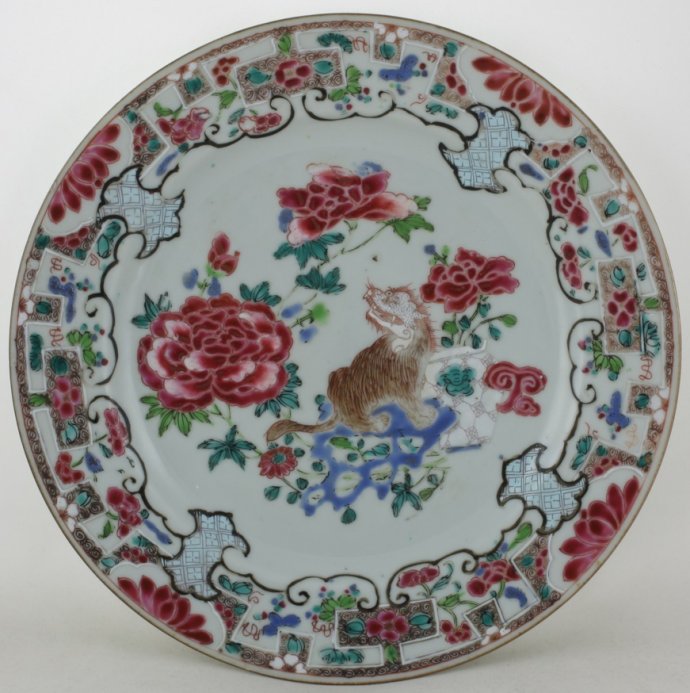
Sold Ceramics - Sold Famille Rose wares 1725-1800 - Dishes - Page 2
Object 2011618
Dish
China
1730-1740
Height 25 mm (0.98 inch), diameter 229 mm (9.02 inch), diameter of footring 124 mm (4.88 inch), weight 325 grams (11.46 ounce (oz.))
Dish on footring with a flat underglaze brown-edged rim (jia mangkou). Decorated in various famille rose enamels and gold with a central peony-spray and a shi-tzu a Chinese Buddhist Lion-dog (Dog of Fo) sitting on taihu (garden) rocks. On the rim reserves filled with half flowerheads and reserves filled with a trellis pattern both on a whorl-pattern ground. The reverse is undecorated.
The 'Chinese lion' or shi-tzu (Dog of Fo) is supposed to be the Chinese conception of a creature never seen in China but told of by travellers or copied from the pictures from India as there are no records of lions in ancient Chinese writings before about 250 A.D. It is also called a Chinese Dog or Dog of Fo (Buddha) from which it is clear that dog-like characteristics prevail over the original leonine ones. The lion symbolizes guardianship and protection, from which belief is derived the practice of placing statues of lions at the doors of palaces and tombs as guardians of both the living and the dead against all evil.
For an identically shaped, sized and decorated, sold, dish, please see:
Sold Ceramics - Sold Famille Rose wares 1725-1800 - Dishes - Page 1 - Object 2010285.
This design was copied by Samson in Paris in the second half of the 19th century.
(This dish is not included in this sale/offer)
Condition: Three fleabites and a filled frit with a connected hairline to the reverse rim.
References:
Jacquemart & Le Blant 1862, pp. 77-105
Price: Sold.

Sold Ceramics - Sold Famille Rose wares 1725-1800 - Dishes - Page 2
Object 2011827
Dish
China
1740-1760
Height 45 mm (1.77 inch), diameter of rim 233 mm (9.17 inch), diameter of footring 132 mm (5.20 inch), weight 422 grams (14.89 ounce (oz.))
Dish on footring, straight rim. Decorated in various famille rose enamels with a scalloped medallion with chrysanthemums and various other, scattered, single flower sprays. The sides with four peaches and four leaf-shaped panels filled with a flower spray on a light brown ground with grey marbling. The reverse is undecorated.
According to Jörg Chinese porcelain for the domestic market often has a decoration or ground imitating other materials, for example, woodgrain, lacquerwork, jade, bamboo or bronze. This occurs less on export porcelain. This dish has been painted to imitate marble or soapstone. The Van Diepen Collection has a fish dish with strainer and a teacup and saucer, all four decorated in this way and possibly all parts of the same service for the objects please see:
Condition: A frit and a hairline to the rim.
References:
Jacquemart & Le Blant 1862, pp. 77-105
Price: Sold.

Sold Ceramics - Sold Famille Rose wares 1725-1800 - Dishes - Page 2
Object 2012092
Dish
China
1730-1740
Height 45 mm (1.77 inch), diameter of rim 286 mm (11.26 inch), diameter of footring 163 mm (6.42 inch), weight 643 grams (22.68 ounce (oz.))
Dish on footring with an underglaze brown-edged open lotus-shaped rim (jia mangkou). Decorated in various famille rose enamels and gold. In the centre a flowering peony, Chinese carnation and a lily (auspicious symbols of longevity and eternal youth). On the sides and rim peonies, chrysanthemums and narcissi with leaves, on a spiral diaper ground. On the reverse nine stylized lingzhi fungi of immortality.
The dish is modelled as an open lotus flower and is characteristic of the more de luxe kind of famille rose that was made for the Western market. It fully corresponds to Jingdezhen production of the late Yongzheng and early Qianlong eras, when decoration often appears on dishes and bowls consisting of single floral sprays without rocks, bordered on the edge with floral ornamentation composed into lobed bands on a spiral pattern ground. We can find in worldwide collections a whole range of identical or more-or-less similar patterns, often differing only in minor details. Similar pattern are recorded in Europe from as early as the 1730s. (Suchomel 2015, p.404)
For a similarly decorated dish, please see:
-
Sold Ceramics - Sold Famille Rose wares 1725-1800 - Dishes - Page 1 - Object 201017.
-
Sold Ceramics - Sold Famille Rose wares 1725-1800 - Dishes - Page 1 - Object 201038.
Condition: Some shallow frits to the footring, two hairlines and a shallow glaze chip to the rim.
References:
Jacquemart & Le Blant 1862, pp. 77-105
Price: Sold.
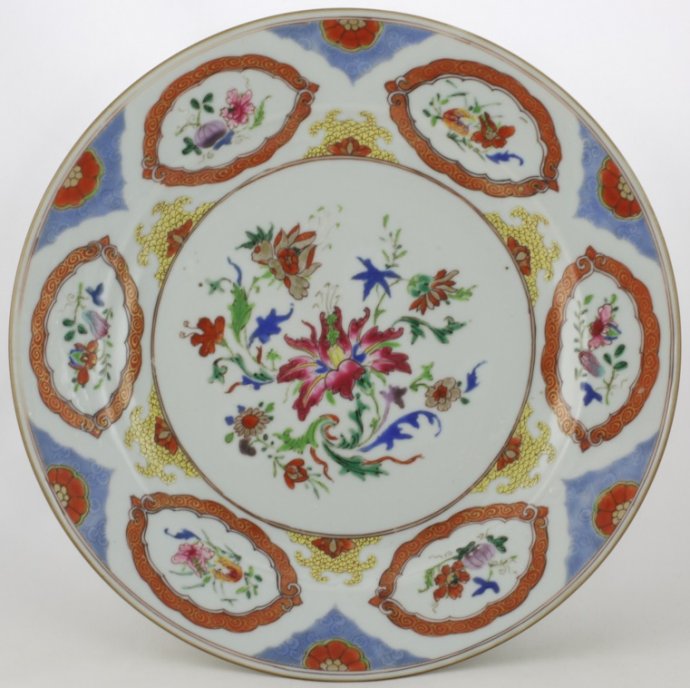
Sold Ceramics - Sold Famille Rose wares 1725-1800 - Dishes - Page 2
Object 2011722
Dish
China
1740-1760
Height 33 mm (1.30 inch), diameter of rim 259 mm (10.20 inch), diameter of footring 137 mm (5.39 inch), weight 612 grams (21.59 ounce (oz.))
Dish on footring, flat underglaze brown-edged rim (jia mangkou). Decorated in various famille rose enamels with gold and other overglaze enamels, with various flower sprays on the sides and rim six oval shaped cartouches filled with flower sprays and fruiting branches separated by wedges with half flowerheads. On the reverse four flower sprays.
Howard states that this apparently Chinese design clearly derives from the second design of Cornelis Pronk, 'The Four Doctors' which has a very similar border formation but with more elaborate details. It is probable that the interest caused in Canton by the Pronk border designs prompted a Chinese workshop to produce a similar effect at much lower cost, using patterns with which it was more familiar, for Dutch supercargoes or private traders of other countries. (Howard 1994, pp.80-81, cat. 64)
For an identically decorated dish, please see:
For a dish, decorated in various overglaze enamels, with Cornelis Pronk's 'The Four Doctors' design, please see:
Condition: Perfect.
References:
Price: Sold.

Sold Ceramics - Sold Famille Rose wares 1725-1800 - Dishes - Page 2
Object 2011824
Dish
China
1740-1760
Height 30 mm (1.18 inch), diameter of rim 226 mm (8.90 inch), diameter of footring 120 mm (4.72 inch), weight 345 grams (12.17 ounce (oz.))
Dish on footring, flat, underglaze brown-edged, rim (jia mangkou). Decorated in various famille rose enamels including pink, some black, overglaze blue, green, yellow and coral red with two figures in a partial opened roll surrounded by various flower sprays. On the rim and sides ruyi heads tied with swirling ribbons to large pomegranates in between geometrical patterns on a frogspawn ground alternating with panels filled with flowerheads on a pink ground and a yellow ruyi heads with a tassel. The reverse is undecorated. On the base a rectangular paper collectors label with the number '179' and a rectangular paper label that reads: 'Epoque Kien-Long. Oojrofe, Paris 3.500 frs Décor au rouleau'..
Condition: Some shallow wear to the enamel.
Reference:
Jacquemart & Le Blant 1862, pp. 77-105
Price: Sold.
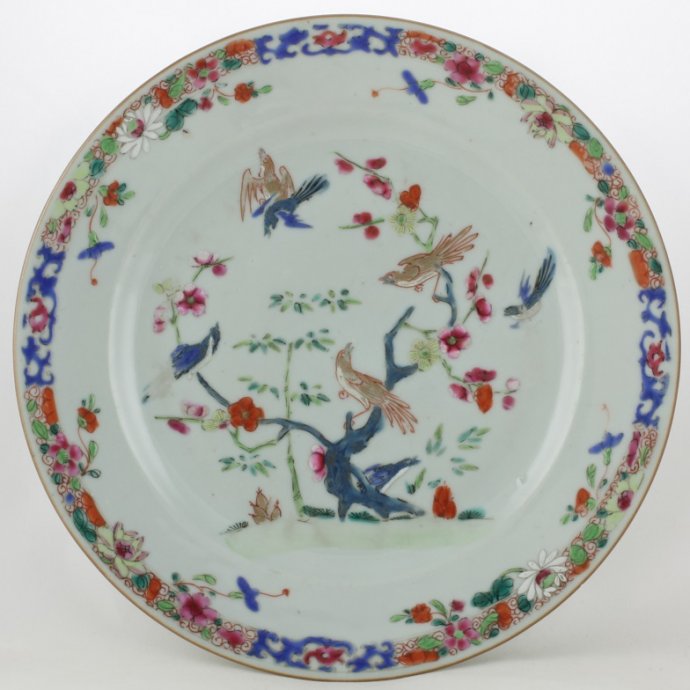
Sold Ceramics - Sold Famille Rose wares 1725-1800 - Dishes - Page 2
Object 2011721
Dish
China
1740-1760
Height 24 mm (0.94 inch), diameter of rim 229 mm (9.02 inch), diameter of footring 121 mm (4.76 inch), weight 326 grams (11.50 ounce (oz.))
Dish on footring with a flat underglaze brown-edged rim (jia mangkou). Polychrome decorated in iron-red, black, gold and other overglaze enamels, with a bamboo tree and seven birds, three in flight and four perched on the branches of a flowering prunus tree. On the rim a flower head border with leafy scrolls reserved on a cell-pattern ground alternating with florets between scrolls. The reverse is undecorated.
Birds and animals figure largely in Chinese symbolism, and many representations of them are to be seen in pictures, on chinaware, in bronze or stone, and as architectural reliefs, etc. (Williams 1976, pp.41-42)
Condition: A tiny fleabite to the rim
References:
Price: Sold.

Sold Ceramics - Sold Famille Rose wares 1725-1800 - Dishes - Page 2
Objects 2011610ABC & 2011633ABC
Six dishes
China
1735-1750
2011610
(A) Height 29 mm (1.14 inch), diameter of rim 228 mm (8.98 inch), diameter of footring 128 mm (5.04 inch), weight 337 grams (11.89 ounce (oz.))
(B) Height 24 mm (0.95 inch), diameter of rim 228 mm (8.98 inch), diameter of footring 128 mm (5.04 inch), weight 348 grams (12.28 ounce (oz.))
(C) Height 26 mm (1.02 inch), diameter of rim 230 mm (9.06 inch), diameter of footring 123 mm (4.84 inch), weight 370 grams (13.05 ounce (oz.))
2011633
(A) Height 28 mm (1.10 inch), diameter of rim 228 mm (8.98 inch), diameter of footring 122 mm (4.80 inch), weight 344 grams (12.13 ounce (oz.))
(B) Height 28 mm (1.10 inch), diameter of rim 229 mm (9.02 inch), diameter of footring 122 mm (4.80 inch), weight 387 grams (13.65 ounce (oz.))
(C) Height 26 mm (1.02 inch), diameter of rim 228 mm (8.98 inch), diameter of footring 127 mm (5.00 inch), weight 343 grams (12.10 ounce (oz.))
Six dishes on footrings, flat underglaze brown-edged rims (jia mangkou). Decorated in various famille rose enamels, iron-red, black, gold and other overglaze enamels with a seated lady and two servants. One servant is holding a fan behind the seated lady while the other is pouring a cup of tea. The central decoration is surrounded by a floral scroll in rococo-style. On the rim a spearhead pattern border (the shape resembling a spearhead while in fact they are stylised ruyi motifs). The reverses are undecorated.
The design on these dishes derived from an old Chinese novel named 'The drunken Concubine', one of the masterpieces by Mei Lan-Fang (a famous opera actor and legend, famous for performing a female role on stage). The story happened in Tang Dynasty around 745-755 AD. It is almost a one-person show. The story is quite simple. Mei had made this play famous by his vivid performance reflecting the concubine's disappointment, her drunken charming, and her intentional show-off of her beauty. There are many movements difficult to perform, including drinking a cup with the performer's teeth only and placing the cup on the tray by bending over backwards.
YANG Yu-Huan was Emperor Ming-Huang's favourite concubine. One evening the two had arranged to meet in a pavilion in the imperial gardens after the Emperor was off his duty. So YANG prepared a banquet and was sitting there waiting for him. But the Emperor failed to his promise and went to see one of his other beautiful concubines. The two eunuchs, Gao Li-Shi and Pei Li-Shi, who were serving YANG, informed her of her humiliating position.
Furious and depressed by the news, YANG decided to have the banquet alone and ordered the eunuchs to serve the alcoholic drink. YANG showed various stages of intoxication, her jealousy and bitterness, and her intention to forget all the unhappiness. She pretended at first that she was not drunk, but gradually was out of self-control. She scorned the eunuchs when they tried to help. She tried to stand up but was forced to lean on the table for support. When she tried to walk, her steps faltered and her legs were unsteady, and eventually had to be supported by her maids.
The two eunuchs were feeling sad and feared that she might ask for more alcoholic drinks. They felt they ought to refuse to serve more but they couldn't. To quiet YANG, the eunuchs told her that the Emperor had arrived. When she discovered that the Emperor was not coming she became angry again. She ordered one of the eunuchs to go and commanded the Emperor to drink with her. When the eunuch refused to do such she got his face slapped. Taking off the eunuch's hat she placed it on her own head and pretended to walk like a man. Then she threw it at the eunuch.
The eunuchs gradually persuaded her to return to her chambers, and she finally agreed and staggered away assisted by her maids.
(source: www.chinahighlights.com and S. Fan)
For dishes decorated with an identically central design, please see:
- Collecting Chinese Export Porcelain, (E. Gordon, Universe Books, New York, 1977), p. 14.
- Chinese Export Porcelain. Chine de Commande from the Royal Museum of Art and History in Brussels, exhibition catalogue Hong Kong Museum of Art, (C.J.A. Jörg, The Urban Council, Hong Kong, 1989), pp.256-257, cat. 102.
- 300 Treasures, (F. Suchomel, Academy of Arts, Architecture and Design in Prague, Prague, 2015), p.413, cat. 251.
Condition:
2011610
(A): a firing flaw, a fleabite and fine crazing to the glaze.
(B): two fleabites, a Y-shaped glaze hairline to the centre (not visible on the reverse) fine crazing to the glaze.
(C): three fleabites, three frits and two chips.
2011633
(A): a firing flaw, a fleabite and fine crazing to the glaze.
(B): six fleabites, four frits and a hairline.
(C): a firing flaw, a fleabite and two frits.
References:
Price: Sold.
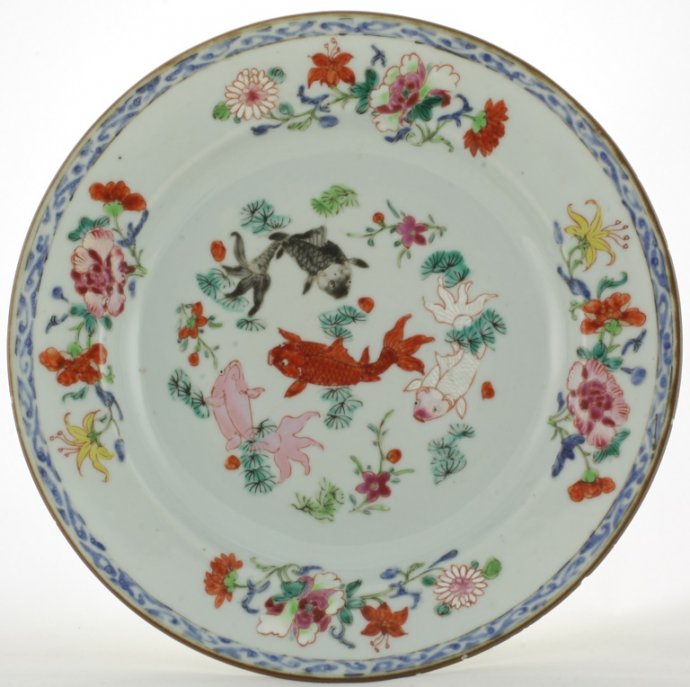
Sold Ceramics - Sold Famille Rose wares 1725-1800 - Dishes - Page 2
Object 2011250
Dish
China
1740-1760
Height 30 mm (1.18 inch), diameter of rim 226 mm (8.90 inch), diameter of footring 120 mm (4.72 inch)
Dish on footring, flat rim. Decorated in various famille rose enamels, gold and other overglaze enamels, with four carp among water plants. On the sides and rim four flower sprays. The reverse is undecorated. On the base a rectangular paper collectors label that reads: '74'.
Large dishes with a comparable decoration in underglaze blue, as well as in underglaze blue with enamel colours and (as here) only in enamel colours were part of the cargo on board the Dutch East India Company VOC ship "De Geldermalsen" wrecked on its home voyage in 1752. (Jörg 2002/2, p.118)
From 1745 onward, Dutch East India Company VOC records mention "fish bowls". The name "fish bowl" is somewhat misleading, since it reminds one of goldfish. But naturally here a dish is meant, intended especially to serve fish. In papers from 1752/3 we encounter both terms: the same object is sometimes called "fish bowl", at other times a "fish dish". They are always easily recognisable by the decoration: four carp among water plants. Once again, there are three types: blue-and-white, Imari and enamel colours. The blue-and-white kind has been purchased on the merchants own initiative, for it does not occur in the order for 1750. There are four smaller dishes to match each fish dish, of course with the same pattern, to be used for shrimps or butter, according to the order for 1750. (Jörg 1986/1, pp.82-85)
For these comparably decorated dishes, please see:
For a comparably, in Chinese Imari with famille rose enamel, decorated dish, please see:
Condition: A hairline, two chips, one with a connected hairline and some tiny frits, all to the rim.
References:
Amsterdam 1986, lots 3189-3200
Price: Sold.
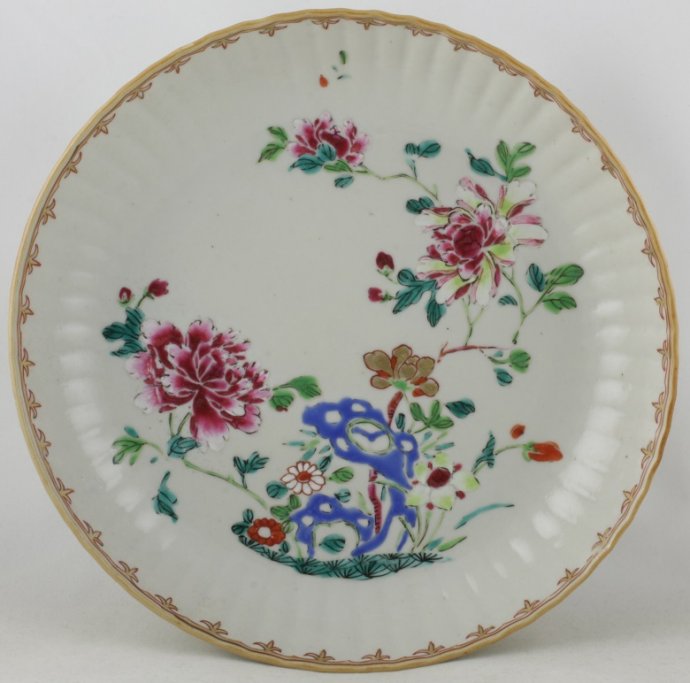
Sold Ceramics - Sold Famille Rose wares 1725-1800 - Dishes - Page 2
Object 2010766
Dish
China
c.1750
Height 31 mm (1.22 inch), diameter of rim 207 mm (8.15 inch), diameter of footring 118 mm (4.65 inch), weight 250 grams (8.82 ounce (oz.))
Dish on footring, lobed underglaze brown-edged rim (jia mangkou). Decorated in various famille rose enamels with flowering plants growing from taihu (garden) rocks. The sides are undecorated. Around the rim a spearhead-pattern border. The reverse is undecorated.
The term famille rose was first coined by the 19th-century French author Albert Jacquemart, who distinguished between specific groups in his descriptions of Oriental ceramics. (Jörg 2003/2, p.25)
After c.1730 famille rose rapidly succeeded famille verte as the mainstyle of enamelling for the Western export markets. About half of the regular export assortment of the Dutch East India Company, (Vereenigde Oost-Indische Compagnie, VOC) and other companies consisted of 'enamelled' wares, as polychrome porcelain was generally called then, with the pink enamel dominant in a palette which also included green, iron-red, yellow, brown, black, overglaze blue and details heightened with gold. These more ordinary wares were less refined and not so well painted but nevertheless sold very well in Europe. (Jörg & Van Campen 1997, p.206)
Condition: Some firing flaws and a tiny frit to the footring.
References:
Jacquemart & Le Blant 1862, pp. 77-105
Price: Sold.

Sold Ceramics - Sold Famille Rose wares 1725-1800 - Dishes - Page 2
Object 2010731
Large dish
China
1740-1760
Height 32 mm (1.26 inch), diameter of rim 315 mm (12.40 inch), diameter of footring: 190 mm (7.48 inch), weight 791 grams (27.90 ounce (oz.))
Large dish on footring, flat rim with a scalloped edge. Decorated in various famille rose enamels, iron-red and gold with scattered 'German flowers'. Around the rim a spearhead pattern border. The reverse is undecorated.
This decoration was closely copied by the Chinese porcelain painter from a Meissen or other factory example.
The term 'famille rose' was first coined by the 19th-century French author Albert Jacquemart, who distinguished between specific groups in his descriptions of Oriental ceramics. (Jörg 2003/2, p.25),
For similarly decorated objects, please see;
- Chinese Export Porcelain. Chine de Commande from the Royal Museum of Art and History in Brussels, exhibition catalogue Hong Kong Museum of Art, (C.J.A. Jörg, The Urban Council, Hong Kong, 1989), pp. 234-235, cat. 93.
- Chinese Export Porcelain in the Reeves Center Collection at Washington and Lee University, (Th.V. Litzenburg, London 2003), p.71, cat. 54.
- 300 Treasures, (F. Suchomel, Academy of Arts, Architecture and Design in Prague, Prague, 2015), p.436, cat. 270.
Condition: Some glaze rough spots to the rim and a chip to the base.
References:
Jacquemart & Le Blant 1862, pp. 77-105
Price: Sold.



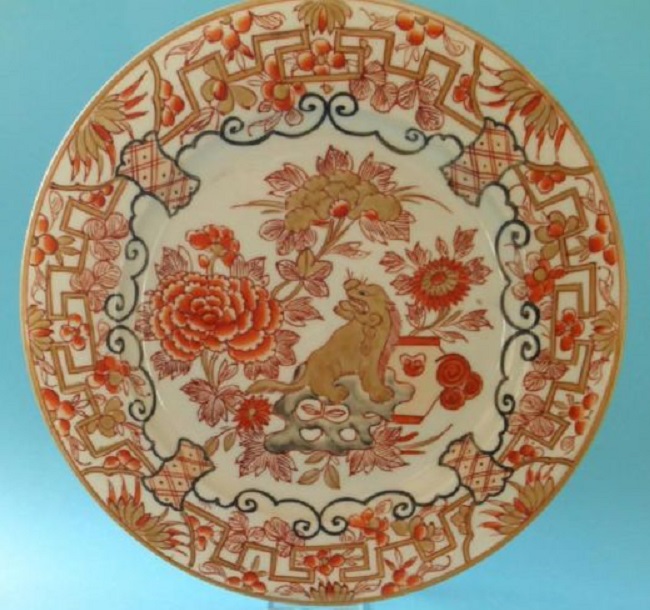
 create websites
create websites